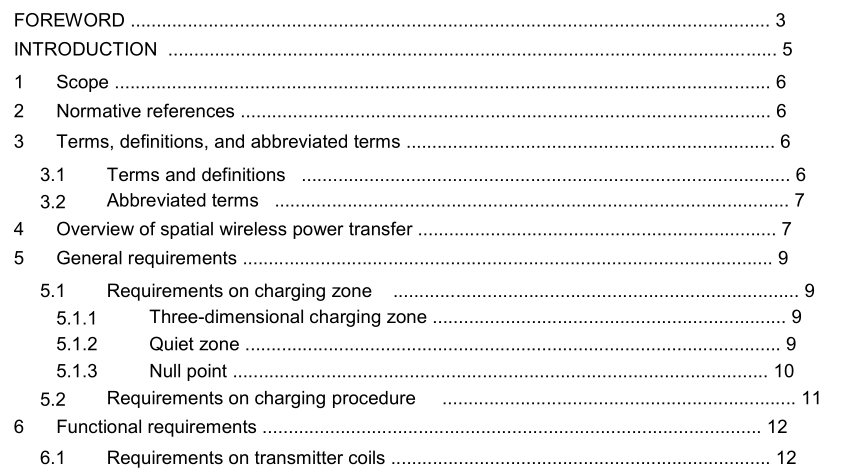IEC 63245-1-2021 pdf Spatial wireless power transfer based on multiple magnetic resonances – Part 1: Requirements

3.1.4 spatial wireless power transfer system group implementing spatial wireless power transfer in which the power source can deliver power and data to the power-receiving device Note 1 to entry: In special cases, a spatial wireless power transfer system can consist of only a single power source and only a single power-receiving device. Note 2 to entry: Spatial wireless power transfer system includes the case in which a power source has the ability to access a power-receiving device through a relay from other power sources when the power source attempts to deliver data to the receiving device. In this document, “data” means control and management data for wireless power transfer. [SOURCE: IEC 62827-3:2016, 3.1.3] 3.1.5 transmitter coil component of a wireless power transmitter that converts electric current to magnetic flux [SOURCE: IEC 63006:2019, 3.1.48] 3.2 Abbreviated terms 2D two-dimensional 3D three-dimensional SWPT spatial wireless power transfer SWPT-MMR spatial wireless power transfer based on multiple magnetic resonances WPT wireless power transfer 4 Overview of spatial wireless power transfer IEC TR 62869 describes types of WPT physical layer technologies. Among the technologies, electromagnetic induction and magnetic resonance technologies are dominantly used in recent industries. The IEC PAS 63095 and WPC Qi series specifies WPT based on electromagnetic induction technology, whereas IEC 63028 specifies WPT based on magnetic resonance technology. A spatial wireless power transfer (SWPT) system delivers the electronic power to one or more receivers within a spatial space. Figure 1 shows a conceptual image of SWPT described in IEC 62827-3.
5.1.2 Quiet zone For transferring electric energy to a receiver in any position within a 3D charging zone, energy density in the charging zone shall be equalized corresponding to each of the magnetic fields formed on the transmitting coils. To equalize energy density within the charging zone, at least one pair of transmitter coils are arranged to face each other and they generate a magnetic field by using the current supplied from at least one power source. The 3D space with equalized energy density is referred to as a “quiet zone”. Figure 4 and Figure 5 show interaction between transmitter coils for generating a quiet zone. A pair of transmitter coils generates a quiet zone in one direction. To add a quiet zone in another direction, an additional pair of transmitter coils can be arranged.
- Previous:IEC PAS 63313-2021 pdf Position statement on germicidal UV-C irradiation UV-C safety guidelines
- Next:IEC 63171-2-2021 pdf Connectors for electrical and electronic equipment – Part 2: Detail specification for 2-way, shielded or unshielded, free and fixed connectors: mechanical mating information, pin assignment and additional requirements for type 2
- ISO IEC 27050-4-2021 pdf Information technology — Electronic discovery — Part 4: Technical readiness
- ISO IEC 27036-1-2021 pdf Cybersecurity — Supplier relationships — Part 1: Overview and concepts
- ISO IEC 27013-2021 pdf Information security, cybersecurity and privacy protection — Guidance on the integrated implementation of ISO/IEC 27001 and ISO/IEC 20000-1
- ISO IEC 26580-2021 pdf Software and systems engineering — Methods and tools for the feature- based approach to software and systems product line engineering
- ISO IEC 24735-2021 pdf Information technology — Office equipment — Method for measuring digital copying productivity
- ISO IEC 24711-2021 pdf Information technology — Office equipment — Method for the determination of ink cartridge yield for colour inkjet printers and multi- function devices that contain printer components
- ISO IEC 23544-2021 pdf Information Technology — Data centres — Application Platform Energy Effectiveness (APEE)
- ISO IEC 23510-2021 pdf Information technology — 3D printing and scanning — Framework for an Additive Manufacturing Service Platform (AMSP)
- ISO IEC 23127-1-2021 pdf Information technology — Learning, education, and training — Metadata for facilitators of online learning — Part 1: Framework
- ISO IEC 23126-2021 pdf Information technology for learning, education and training — Ubiquitous learning resource organization and description framework
- IEC 62830-5-2021 pdf Semiconductor devices – Semiconductor devices for energy harvesting and generation – Part 5: Test method for measuring generated power from flexible thermoelectric devices
- IEC 62148-21-2021 pdf Fibre optic active components and devices – Package and interface standards – Part 21: Design guidelines of electrical interface of PIC packages using silicon fine-pitch ball grid array (S-FBGA) and silicon fine-pitch land grid array (S‑FLGA)
- IEC 62083-2009 pdf Medical electrical equipment – Requirements for the safety of radiotherapy treatment planning systems
- IEC 61188-6-2-2021 pdf Circuit boards and circuit board assemblies – Design and use – Part 6-2: Land pattern design – Description of land pattern for the most common surface mounted components (SMD)
- IEC 60183-2015 pdf Guidance for the selection of high-voltage A.C. cable systems
- BS ISO IEC 15420-2009 pdf Information technology一 Automatic identification and data capture techniques EAN/UPC bar code symbology specification
- BS ISO IEC 19762.5-2008 pdf Information technology一 Automatic identification and data capture (AIDC) techniques – Harmonized vocabulary Part 5: Locating systems
- BS IEC 60860-2014 pdf Radiation protection instrumentation一 Warning equipment for criticality accidents
- ISO IEC 24735-2021 pdf Information technology — Office equipment — Method for measuring digital copying productivity
- ISO IEC 24711-2021 pdf Information technology — Office equipment — Method for the determination of ink cartridge yield for colour inkjet printers and multi- function devices that contain printer components